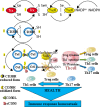The potential role of thioredoxin 1 and CD30 systems as multiple pathway targets and biomarkers in tumor therapy
- PMID: 21739118
- PMCID: PMC3176405
- DOI: 10.1007/s00262-011-1068-5
The potential role of thioredoxin 1 and CD30 systems as multiple pathway targets and biomarkers in tumor therapy
Abstract
Our progress in understanding pathological disease mechanisms has led to the identification of biomarkers that have had a considerable impact on clinical practice. It is hoped that the move from generalized to stratified approaches, with the grouping of patients into clinical/therapeutic subgroups according to specific biomarkers, will lead to increasingly more effective clinical treatments in the near future. This success depends on the identification of biomarkers that reflect disease evolution and can be used to predict disease state and therapy response, or represent themselves a target for treatment. Biomarkers can be identified by studying relationships between serum, tissue, or tumor microenvironment parameters and clinical or therapeutic parameters at onset and during the progression of the disease, using systems biology. Given that multiple pathways, such as those responsible for redox and immune regulation, are deregulated or altered in tumors, the future of tumor therapy could lie in the simultaneous targeting of these pathways using extracellular and intracellular targets and biomarkers. With this aim in mind, we evaluated the role of thioredoxin 1, a key redox regulator, and CD30, a cell membrane receptor, in immune regulation. Our results lead us to suggest that the combined use of these biomarkers provides more detailed information concerning the multiple pathways affected in disease and hence the possibility of more effective treatment.
Figures



References
-
- Soini Y, Kahlos K, Näpänkangas U, et al. Widespread expression of thioredoxin and thioredoxin reductase in non-small cell lung carcinoma. Clin Cancer Res. 2001;7:1750–1757. - PubMed
-
- Kakolyris S, Giatromanolaki A, Koukourakis M, et al. Thioredoxin expression is associated with lymph node status and prognosis in early operable non-small cell lung cancer. Clin Cancer Res. 2001;7:3087–3091. - PubMed
Publication types
MeSH terms
Substances
LinkOut - more resources
Full Text Sources

